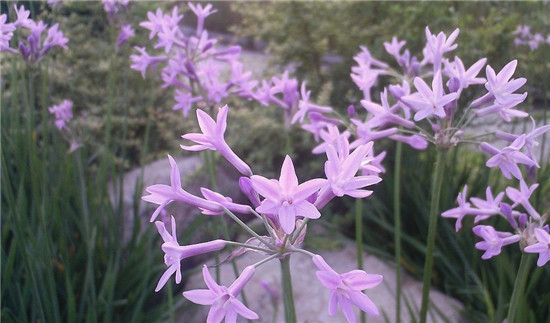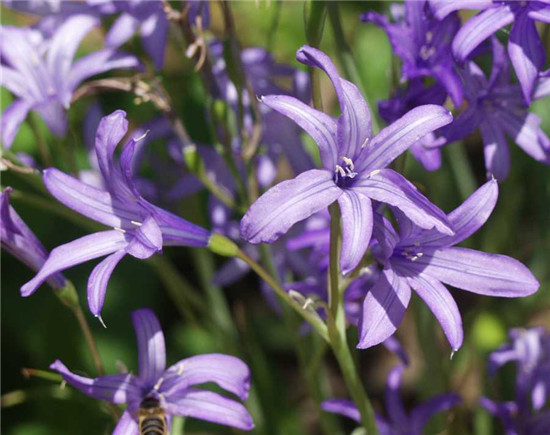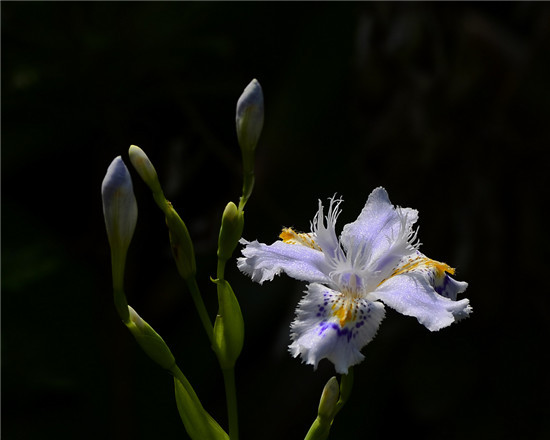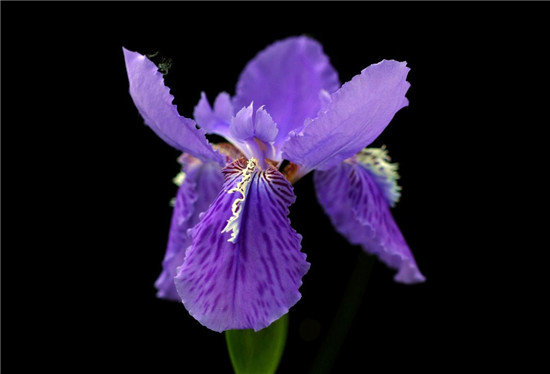Cultivation of Iris garlic cultivation of Iris garlic
Iris garlic is a perennial herb of the genus Iris in Amaryllidaceae. Iris garlic has large and beautiful flowers. Let's take a look at its cultivation.

Iris garlic is a perennial herb. The bulb is ovoid, 1.5-2.5 cm long and 2.5 cm in diameter, with brown bulb bark with light longitudinal striations outside. Leaves usually 3-8, clustered at base of stem, narrowly linear. The flowering stem is drawn in spring, 10-40 cm high, with 1-3 smaller leaves in the lower part, umbels composed of 3-6 flowers at the top, or racemes shortened in shape, with flamelike involucre, involucral bracts membranous, 2-3, white or green, lanceolate, up to 3.5 cm long, apex acuminate and awn-shaped. In addition to the apical inflorescence, sometimes 1-3 flowers can be produced in the axils of the lower leaves.
Pedicels long and short; bracteoles smaller, membranous; perianth blue-purple to dark blue-purple; tepals free, oblanceolate or narrower, 2-3.5 cm long and 3-7 mm wide, apex subacute, with 3-5 ribs in the center; stamens inserted at base of perianth segments, 2 whorls, 3 inner whorls longer, 3 outer whorls shorter, filaments glabrous, subfiliform, anther basifixed; ovary inferior, subclavate, 3-loculed, stigma 3-lobed. Capsule; seeds small, black. The florescence is from May to June.

The national flower of France is Gyabgon Iris of Iridaceae, which is beautiful and graceful, very similar to lilies. Iris and Lily belong to two completely different families, although at first glance, it seems that both of them have six "petals", but they do not know that Iris has only three petals, and the other three petals are sepals that protect buds. It is just because these three petal-shaped sepals are so similar to petals that they are often unrecognizable. In addition, the "petals" of irises are half upward and half downward, while the petals of lilies are all upward. In addition, some irises have three long tongue-shaped petals transformed from a female core deep in the heart of the flower. Because Europeans often call irises "lilies", many people think that the national flower of France is lilies. In modern Chinese, fleur-de-lis is often translated as "Golden Lily", and the correct translation should be "Iris".

Iris culture method
Ramet and sowing methods were often used. Ramet can be carried out after flowering in spring or autumn, and it can be planted once after 2-4 years. When dividing the rhizome, note that each piece should have 2-3 adventitious buds. Seeds should be sowed immediately after maturity, and it takes 2-3 years for seedlings to blossom. The planting distance is 45-60cm and the planting depth is 7-8cm. It can also be promoted by cultivation.
1. Planting: ground planting, also known as potted plants. It is often cultivated in open field. It is suitable for the upper soil with good drainage and moderate moisture. Mature compost should be applied before planting, and oil meal and plant ash can also be used as base fertilizer. The planting depth of the plant is 5 meters lower than that of the ground on the sparse orange soil with good drainage, and the top of the rhizome on clay is slightly higher than the ground to facilitate plant growth.

two。 Temperature and light: Iris is full of sunlight and slightly shade-resistant. It can be cultivated in open field. Strong adaptability, general normal management will be able to grow vigorously.
3. Watering and fertilization: base fertilizer can be applied before planting, fertilizing once a year in autumn, and chemical fertilizer can be applied during the growing period. Watering depends on the situation, watering once a week during the growing period of open field cultivation, and the amount of watering decreases gradually with the decrease of air temperature. In cold areas in winter, the bushes should be covered with stable manure or leaves to protect against cold.
These are all the contents of the planting and cultivation of iris garlic that I have summarized for you. I hope this article can help you. Please continue to follow us.
Related
- Wuhan Hospital Iron Tree Blooming Result Was Instantly Frightened by the Gardener Master
- Which variety of camellia is the most fragrant and best? Which one do you like best?
- What is the small blue coat, the breeding methods and matters needing attention of the succulent plant
- Dormancy time and maintenance management of succulent plants during dormancy
- Minas succulent how to raise, Minas succulent plant pictures
- What are the varieties of winter succulent plants
- How to raise succulent plants in twelve rolls? let's take a look at some experience of breeding twelve rolls.
- Attention should be paid to water control for succulent plants during dormant period (winter and summer)
- Watering experience of twelve rolls of succulent plants
- Techniques for fertilizing succulent plants. An article will let you know how to fertilize succulent plants.



